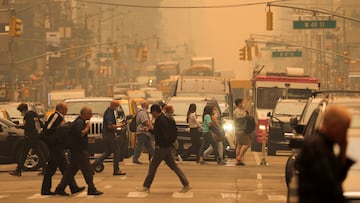How is air pollution measured? What are the six categories?
Too much air pollution is harmful to one’s health. Knowing how much is about and what kinds you could be breathing in can help you live a healthier life.

The massive wildfires raging across Canada have sent plumes of smoke drifting across large swathes of North America causing air pollution levels to soar. New York City shot to the top of the list for worst air quality according to IQAir, a Swiss air quality technology company, which reports measurements from around the world.
The level was so high that it hit a level more than double that of the number two on the list for Wednesday, Dubai in the United Arab Emirates. But how is air quality measured and what substances that we breathe do we need to watch out for?
How is air pollution measured?
Ground instruments and satellites are constantly monitoring what is in the air. On the ground there are over 4,000 air monitoring stations around the US that track six different types of air pollution. The two most common types of air pollution are particle pollution (PM2.5) and ozone which are reported on an hourly basis, but the stations also monitor carbon monoxide, sulfur dioxide, nitrogen dioxide and lead.
The measurements are reported as the Air Quality Index, or AQI, and it reads a bit like a thermometer with the range from 0 to 500. The reading is broken into six categories corresponding to different levels of health risk, each with a different color to make it easier for people to determine if the air is unhealthy.
Visit https://t.co/KcZBXrvGNe to get up-to-date information about air quality where you live and sign up to receive local air quality information via email at https://t.co/GTTH9l7BlB. You can also review data from air quality monitors across the world! pic.twitter.com/yA41d90EUg
— airnow (@AIRNow) June 2, 2023
Those that want to check what the current AQI is and the forecast for your city or another can check out the Environmental Protection Agency (EPA) AirNow webpage.
What are the six AQI categories?
Related stories
The first four AQI categories increase at intervals of 50 but the two highest levels have wider ranges. The two lowest levels go from 0-50, “Good”, represented by green and 51-100, “Moderate”, represented by yellow. Below 100 the air quality is considered to be satisfactory for all groups.
Above that level, from 101-150, “Unhealthy for Sensitive Groups”, represented by Orange, the air quality is not likely to affect the general public but those in sensitive groups may experience health effects. The following three levels, “Unhealthy” (151-200 color red), “Very Unhealthy” (201-300 color purple) and “Hazardous” (301-500 color Maroon), the air quality is unhealthy for all groups.


